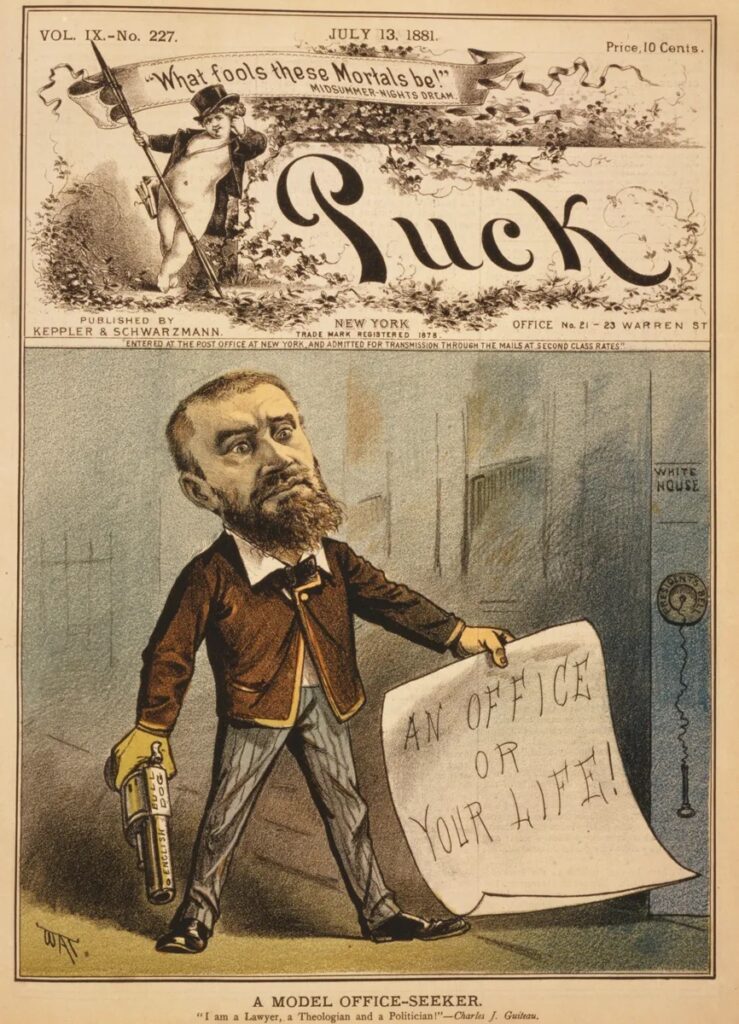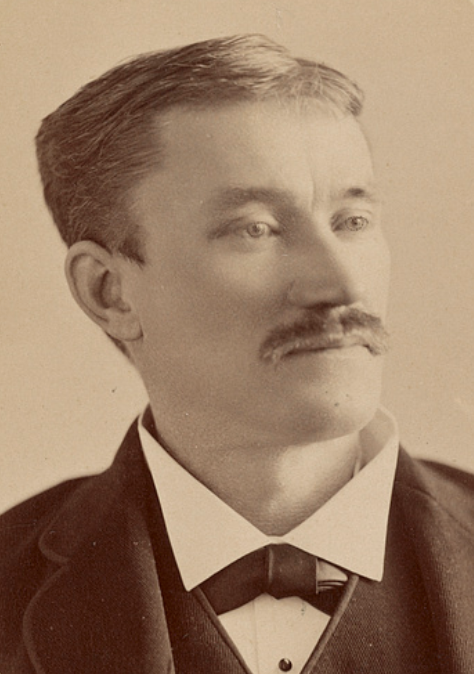“Moral imbecility burst onto the national scene on July 2, 1881, when Charles Guiteau shot President James A. Garfield in the crowded Baltimore and Potomac rail station in Washington, D.C. Garfield died eleven weeks later, his body riddled with infection following the ignorant probings and overzealous ministrations of his doctors,” Chelsea Diane Chamberlain wrote in, “Why Wait Until They Commit a Crime?”
Guiteau’s actions induced a media frenzy not only as the would-be assassin Garfield, but for his increasingly delusional behavior while being held before trial.
Born on September 8, 1841, in Freeport, Illinois, Guiteau was ultimately raised by this father, Luther, after his mother’s death in 1848. Jane Guiteau, according to the National Archives, “had suffered from psychosis for much of her life — a mental condition involving a ‘loss of contact with reality and difficulty with social interaction.'” Her son most likely suffered from similar delusions.
From an Insurance Salesman to Politician
In 1880, after Garfield’s election, Guiteau — a failed evangelist, insurance salesman and attorney — thought he’d try his hand at politics.
In the lead up to the election, Guiteau had written a pamphlet outlining Grant’s virtues titled “Grant against Hancock” and then set out for New York to offer his services to the National Republican Committee in July of 1880.
As national leaders arrived at The Fifth Avenue Summit, Guiteau began to distribute his pamphlet, now conveniently dubbed “Garfield against Hancock,” availing himself onto any and all passersby.
In an attempt to quiet him, party leaders humored Guiteau, allowing him to read his pamphlet to the assembly with Garfield standing by his side.
To Guiteau, this moment legitimized his belief that he would soon be entrusted with an important position in the soon-to-be-elected Garfield administration.
GET HISTORY’S GREATEST TALES—RIGHT IN YOUR INBOX
Subscribe to our HistoryNet Now! newsletter for the best of the past, delivered every Monday and Thursday.
In 1880, Guiteau, with memories of his speech still ringing in his mind, wrote to then-secretary of state, William M. Evarts, asking if it was required for all foreign ministers under President Rutherford B. Hayes to retire when the new administration took office the following March. Guiteau noted that he expected to be placed in a high position within Garfield’s cabinet.
According to the archives, Guiteau wrote to both President Garfield and the new secretary of state, James Blaine, claiming a right to the position of consul to Austria “on account of my service during the canvas.” He then added that he felt he should be awarded this post as a “personal tribute” for his efforts. However, he shortly changed his mind and decided that Paris suited him more.
Guiteau kept up his campaign, from letters to in-person visits with Blaine — security was seemingly lax in those days — but after months of enduring incessant campaigning, Blaine had Guiteau’s access to the White House cut off on May 14, 1881.
An incensed Guiteau “quickly dashed off a letter to the President telling him of Blaine’s behavior. He wrote that he had previously considered Blaine a friend and was therefore confused. Nine days later he wrote to Garfield again with a demand that Blaine be dismissed, or ‘otherwise you and the Republican Party will come to grief,’” writes the National Archives.
According to Guiteau’s logic, the 39-year-old felt that it was necessary to murder the president in order to, in his unstable mind, restore the Republican Party.
A Man Wronged?
After stalking Garfield in the capital for weeks, Guiteau found his opportunity to strike on the morning of July 2, 1881, after a newspaper article tipped off the soon-to-be-assassin of the president’s whereabouts.
As Garfield waited for his train inside the Baltimore and Potomac railroad station in Washington, D.C., Guiteau strode behind Garfield, shooting him twice in the back with a .442 Webley, nicknamed the British Bulldog revolver for its large-caliber capacity.
The Bulldog revolver was purchased specifically by Guiteau because he thought it would look impressive in a museum exhibit.
After a third shot punctured his right lung, Garfield cried out, “My God! What is this?”
Garfield’s doctors were unable to remove the bullet, which was lodged in the president’s pancreas, and on September 19, 1881, 80 days after the shooting, Garfield died of blood poisoning.
But Guiteau’s delusions were far from over.
The Many Sayings of Guiteau
Continuing his stunning run of audaciousness, the imprisoned Guiteau — who had previously castrated himself — placed an advert in the local newspaper stating: “I am looking for a wife and see no objection in mentioning it here. I want an elegant Christian lady of wealth, under 30, belonging to a first-class family. Any such lady can address me with the utmost confidence.”
He told The Herald that he had “shot the president without malice or murderous intent.”
But Guiteau wasn’t finished. According to the Archives he “sent a note to Gen. William T. Sherman, asking that his troops take immediate possession of the jail in order to secure his release, explaining that assassinating the president had merely been a ‘political necessity.’ Sherman responded: ‘I don’t know the writer. Never heard of him or saw him to my knowledge.'”

The jury deliberated for one hour before delivering their guilty verdict. Guiteau responded by calling them “low, consummate jackasses.”
After his one appeal was denied, Guiteau was hanged on June 30, 1882 — two days before the anniversary of the assassination. He spent the morning writing to President Chester A. Arthur, telling him “My inspiration is a godsend to you and I presume that you appreciate it…. Never think of Garfield’s removal as murder. It was an act of God, resulting from a political necessity for which he was responsible.”
historynet magazines
Our 9 best-selling history titles feature in-depth storytelling and iconic imagery to engage and inform on the people, the wars, and the events that shaped America and the world.






